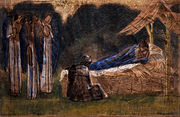
Sir Edward Coley Burne-Jones, 1st Baronet, was a British painter and designer associated with the Pre-Raphaelite Brotherhood which included Dante Gabriel Rossetti, John Millais, Ford Madox Brown and William Holman Hunt. Burne-Jones worked with William Morris as a founding partner in Morris, Marshall, Faulkner & Co in the design of decorative arts.

The Adoration of the Magi or Adoration of the Kings or Visitation of the Wise Men is the name traditionally given to the subject in the Nativity of Jesus in art in which the three Magi, represented as kings, especially in the West, having found Jesus by following a star, lay before him gifts of gold, frankincense, and myrrh, and worship him. It is related in the Bible by Matthew 2:11: "On entering the house, they saw the child with Mary his mother; and they knelt down and paid him homage. Then, opening their treasure chests, they offered him gifts of gold, frankincense, and myrrh. And having been warned in a dream not to return to Herod, they left for their own country by another path".

Morris, Marshall, Faulkner & Co. (1861–1875) was a furnishings and decorative arts manufacturer and retailer founded by the artist and designer William Morris with friends from the Pre-Raphaelites. With its successor Morris & Co. (1875–1940) the firm's medieval-inspired aesthetic and respect for hand-craftsmanship and traditional textile arts had a profound influence on the decoration of churches and houses into the early 20th century.

The Beguiling of Merlin is a painting by the British Pre-Raphaelite painter Edward Burne-Jones that was created between 1872 and 1877.
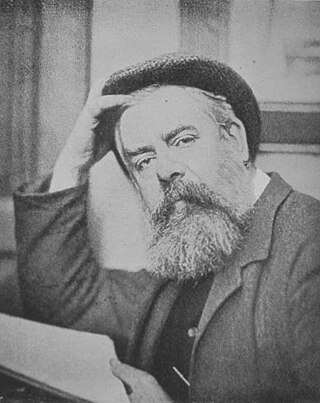
Frederick Hollyer was an English photographer and engraver known for his photographic reproductions of paintings and drawings, particularly those of the Pre-Raphaelite Brotherhood, and for portraits of literary and artistic figures of late Victorian and Edwardian London.
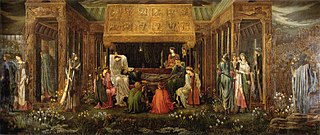
The Last Sleep of Arthur in Avalon is a painting by Edward Burne-Jones, started in 1881. The massive painting measures 279 cm × 650 cm, and is widely considered to be Burne-Jones's magnum opus.

The Star of Bethlehem is a painting in watercolour by Sir Edward Burne-Jones depicting the Adoration of the Magi with an angel holding the star of Bethlehem. It was commissioned by the Corporation of the City of Birmingham for its new Museum and Art Gallery in 1887, two years after Burne-Jones was elected Honorary President of the Royal Birmingham Society of Artists. At 101 1/8 x 152 inches, The Star of Bethlehem was the largest watercolour of the 19th century. It was completed in 1890 and was first exhibited in 1891.

The Adoration of the Magi is a Morris & Co. tapestry depicting the story in Christianity of the Three Kings who were guided to the birthplace of Jesus by the star of Bethlehem. It is sometimes called The Star of Bethlehem or simply The Adoration.

Sponsa de Libano is a painting by the Pre-Raphaelite artist Edward Burne-Jones dated 1891.

The Holy Grail or San Graal tapestries are a set of six tapestries depicting scenes from the legend of King Arthur and the quest for the Holy Grail. The tapestries were commissioned from Morris & Co. by William Knox D'Arcy in 1890 for his dining room at Stanmore Hall, outside London. Additional versions of the tapestries with minor variations were woven on commission by Morris & Co. over the next decade.

King Cophetua and the Beggar Maid is an 1884 painting by the Pre-Raphaelite artist Edward Burne-Jones. The painting illustrates the story of 'The King and the Beggar-maid", which tells the legend of the prince Cophetua who fell in love at first sight with the beggar Penelophon. The tale was familiar to Burne-Jones through an Elizabethan ballad published in Bishop Thomas Percy's 1765 Reliques of Ancient English Poetry and the sixteen-line poem The Beggar Maid by Alfred, Lord Tennyson.

Pygmalion and the Image is the second series of four oil paintings in the Pygmalion and Galatea series by the Pre-Raphaelite artist Edward Burne-Jones which was completed between 1875 and 1878. The two collections may be seen below, in the Gallery, the first being now owned by Lord Lloyd Webber, and the second housed at the Birmingham Museum & Art Gallery. This article deals with an appraisal of the second series.

The Merciful Knight is a watercolour by the pre-Raphaelite artist Edward Burne-Jones which was completed in 1863 and is currently housed at the Birmingham Museum & Art Gallery.

The Flower Book by Edward Burne-Jones (1833–1898) is a series of 38 round watercolours, each about six inches across, painted from 1882 to 1898. The paintings do not depict flowers; rather, they were inspired by the flowers' names. Burne-Jones called them "a series of illustrations to the Names of Flowers". "Not a single flower itself appears", according to his wife Georgiana. They were painted for his private pleasure, many while he was resting at his summer home in Rottingdean, and were described by his wife as the "most soothing piece of work that he ever did". In 1905 Georgiana, by then a widow, published a limited edition of high-quality colour facsimiles.

Georgiana, Lady Burne-Jones was a painter and engraver, and the second oldest of the Macdonald sisters. She was married to the Late Pre-Raphaelite artist Edward Burne-Jones, and was also the mother of painter Philip Burne-Jones, aunt of novelist Rudyard Kipling and Prime Minister Stanley Baldwin, confidante and friend of George Eliot, William Morris, and John Ruskin. She was a Trustee of the South London Gallery and was elected to the parish Council of Rottingdean, near Brighton in Sussex.

The Golden Stairs is one of the best-known paintings by the Pre-Raphaelite artist Edward Burne-Jones. It was begun in 1876 and exhibited at the Grosvenor Gallery in 1880.
Hope is a late oil painting by the Pre-Raphaelite artist Edward Burne-Jones. It was painted on commission for Mrs. George Marston Whitin of Whitinsville, Massachusetts in 1896.
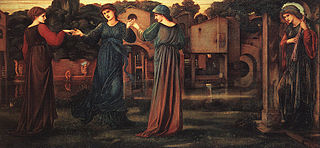
The Mill is an Aesthetic Movement, Renaissance-inspired oil on canvas painting completed by Edward Burne-Jones in 1882. The painting's main feature is three women dancing in front of a mill pond on a summer evening, with a vague wooded landscape spanning the background. The Mill is an oil on canvas painting. It is 91 centimetres (36 in) in height, and 197 centimetres (78 in) in width.
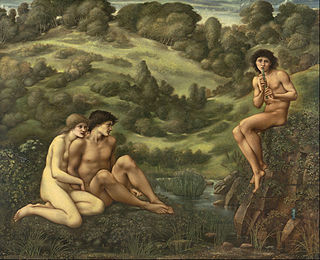
The Garden of Pan is a painting by the pre-Raphaelite artist Edward Burne-Jones which was completed around 1886 and is currently housed at the National Gallery of Victoria.



